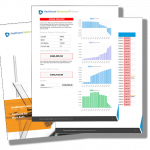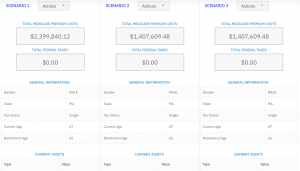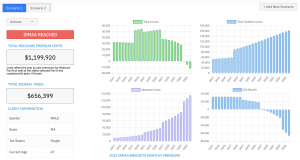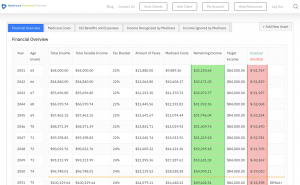Ever opened a letter from the Centers for Medicare & Medicaid Services and felt like you’re trying to decode a secret language? Ever wondered how are medicare premiums calculated? If yes, this is your pit stop.
We’ve all been there – squinting at that paper as if it’s an ancient map leading to hidden treasure. But instead of ‘X’ marking the spot, we have cryptic terms like AGI, MAGI, IRMAA…
This journey might seem daunting but fear not! We’re here to navigate these choppy waters together. Through this expedition into Medicare premiums calculation, we’ll decipher how income impacts Part B and D premiums. Explore penalties for late enrollment in Part B; delve into Advantage Plan costs and more.
Your personal guide through this maze awaits just around the corner… Are you ready?
Understanding the Basics of Medicare Premiums
The cost you pay for your Medicare coverage, or your Medicare premium, is influenced by several factors. The government sets a base premium each year which most beneficiaries pay about 25% of, with the remaining 75% covered by federal funding.
How are Medicare Premiums Calculated?
To calculate your monthly payment, the Centers for Medicaid Services (CMS) use information from your tax return filed two years prior to assess whether you’ll need to contribute more due to higher income. For example, if it’s now 2023 and CMS is calculating this year’s premiums based on a beneficiary’s gross income reported in their federal tax return from 2023.
Your total adjusted gross income plus any non-taxable interest defines what’s known as Modified Adjusted Gross Income (MAGI). This MAGI determines where you fall within various ‘income brackets’, that define how much extra – if anything – you might need to contribute towards both Part B medical insurance and prescription drug coverage under Part D. This additional amount paid above standard premiums due to higher earnings is called an Income-Related Monthly Adjustment Amount (IRMAA).
Factors Influencing Medicare Premiums
Influential factors include not just annual changes made by CMS but also life events like retirement or other reductions in work hours. Such shifts can significantly change one’s modified adjusted gross; therefore altering monthly payments owed too.
If there has been an error in calculation or a significant life event causing reduction in MAGI after filing taxes such as spouse stopped working then adjustments can be requested via Social Security Administration using appropriate forms found at official Medicare website.
Impact of Income on Medicare Part B and D Premiums
Your income plays a crucial role in determining your Medicare premiums. Higher-income beneficiaries shoulder a larger chunk of the total cost for Part B based on their reported earnings to the IRS.
Role of AGI and MAGI in Determining Premiums
The premiums for Part B and Part D are largely based on your AGI or MAGI, which is derived from the tax return of two years prior. These are values derived from your federal tax return two years prior. So, if we’re talking about 2023 premiums, they’d be calculated using data from your 2023 tax returns.
This is where things get interesting with IRMAA – short for income-related monthly adjustment amounts. If you earn above a certain threshold ($91k as an individual or $182k jointly as per 2023 guidelines), this kicks in adding more dollars to what you have to fork out each month.
A fun fact? Monthly Part B premiums can range anywhere between 35% up to a whopping 85% of the total cost if you’re among higher earners. Now that’s some serious moolah.
Moving onto prescription drugs under part D – similar rules apply here too. You could end up paying an additional amount alongside your plan’s base premium depending upon how much dough you rake in annually.
In summary: More money = higher Medicare premium costs. It may not seem fair but it’s Uncle Sam’s way of ensuring everyone gets access to health care regardless of their social security benefits or lack thereof.
But what if you experience an income change? Can it affect your Medicare premiums? A definite YES is the response. For instance, let’s say you’ve stopped working or your spouse has. Or perhaps there was a reduction in work hours or loss of income-producing property. All these scenarios could potentially result in lower premiums. Just remember to inform Social Security about such changes because they might adjust your premium based on this new information.
Key Takeaway:
Your Medicare premiums for Part B and D are closely linked to your income. In other words, the higher your earnings, the more you’ll typically pay in premiums. This system operates based on what Uncle Sam has on record about your earnings from two years prior. But beware – crossing certain earning thresholds could trigger something called IRMAA, which might pile on additional costs.
Consequences of Late Enrollment in Part B
If you’re considering Medicare, timing is crucial. When it comes to signing up for Part B, late enrollment can lead to penalties that increase your monthly premium.
Understanding the Late Enrollment Penalty
The consequences of delaying your sign-up aren’t just immediate; they’re ongoing. If you don’t enroll when first eligible and don’t qualify for a Special Enrollment Period, expect an additional 10% on top of your monthly Part B premium for each year you delay. And this isn’t a one-time slap on the wrist – it lasts as long as you have Part B.
This might seem harsh but consider it like showing up late for dinner at a fancy restaurant. You not only miss out on appetizers (initial coverage), but also get charged extra (penalties) because the chef had to keep everything warm while waiting (providing healthcare services).
The calculation behind this penalty is quite simple: The number of full 12-month periods that could’ve been covered by Part B during which there was no enrollment constitutes what’s called ‘delayed months’. Multiply these delayed months by 10%, add it onto your current monthly payment and voila. There’s your new higher premium.
But wait. What if circumstances made enrolling impossible? Fear not. Certain life events such as losing job-based insurance or moving back from living overseas are considered valid reasons under Special Enrollment Period rules and can help avoid these hefty fines.
Moral of our story? Just like arriving early keeps peace with friends expecting us at dinner parties, timely enrollment in Medicare Part B keeps peace with our pockets. So, plan ahead and save yourself from the late-enrollment blues.
Remember: Knowledge is power, but timing is everything.
Key Takeaway:
Don’t sweat it, if life throws you a curveball like losing your job-based insurance or moving back from abroad, these circumstances could shield you from these extra charges. It’s crucial to remember that timing is key when enrolling in Medicare Part B. If you sign up late, expect ongoing penalties that will increase your monthly premium by an additional 10% for each year of delay. Imagine showing up late to a posh dinner and having to pay more – quite the pricey consequence.
Medicare Advantage Plan Premiums
If you’re familiar with Medicare, you might have heard about the income-related monthly adjustment amounts (IRMAA) for Medicare Advantage plans. This is an additional charge that some people pay on top of their regular plan premiums.
The amount varies depending on your reported modified adjusted gross income from two years prior. So if we’re in 2023, then it’s your tax return filed in 2023 that counts.
For instance, let’s say Bob and Alice are both enrolled in a Medicare Advantage plan. Bob has a higher annual income than Alice based on his federal tax return from two years ago. In this case, IRMAA requires Bob to pay more towards his monthly premium compared to Alice who earns less.
This means that not all beneficiaries pay the same amount for their Medicare Advantage plans. The calculation considers several factors such as modified adjusted gross income and filing status which could result in different premium costs even within the same plan.
Determining Your Monthly Adjustment Amounts
Your exact payment can be found by referring to this chart provided by Social Security Administration (SSA).
The SSA uses your IRS-reported data like MAGI or Modified Adjusted Gross Income and other factors into account when calculating how much extra you’ll need to shell out each month due to IRMAA – yes folks. It’s another acronym but one worth knowing.
However, the base premium is just a starting point. Other factors such as where you live and whether you use tobacco can also affect your final costs.
Avoiding Surprises in Your Medicare Advantage Premiums
The best way to avoid surprises on your monthly premiums is by planning ahead and keeping an eye on your income level. If you anticipate that it will go up, be prepared for possible increases in IRMAA.
an unexpected surge in your payments. Keeping Social Security updated about changes in your work situation helps them tailor the benefits to suit your current needs, ensuring you’re not left out of pocket. Reach out to Social Security without delay if there’s a switch.
Key Takeaway:
Understanding your Medicare Advantage Plan premiums is crucial. They’re calculated using factors like income from two years prior, with higher earners paying more due to the Income-Related Monthly Adjustment Amounts (IRMAA). Your location and lifestyle habits can also impact costs. To avoid surprises, keep tabs on your income and notify Social Security of any changes in your work situation.
Changes in Income and Their Impact on Medicare Premiums
It is essential for Medicare plan enrollees to be aware of how fluctuations in their income may affect the premiums they pay each month. The way this works is through the Income-Related Monthly Adjustment Amount (IRMAA), which influences both Part B medical insurance and prescription drug coverage.
A rise or fall in gross income directly impacts IRMAA, thereby influencing the premium you pay for Medicare benefits. But here’s something surprising: If you’ve stopped working or experienced significant reductions in work hours recently, there might be some good news ahead.
Reporting Income Changes to Social Security
Your first step should be reporting these shifts promptly to Social Security. They use tax return data from two years prior to calculate premiums; so if your latest federal tax return shows higher earnings but current circumstances have changed—like retirement—it’s time for action.
You see, Social Security considers life-changing events such as when you or a spouse stop working as valid reasons for an appeal. So don’t hold back. Appeal their decision based on these adjustments using new evidence like recent tax returns showing reduced adjusted gross income.
The process of doing this isn’t complex either—you just need accurate documentation demonstrating your current financial situation. Here is where you start that journey.
| Impact of Reporting Income Change: | |
|---|---|
| Prior Condition: | Your previous high-income level led to increased monthly adjustment amounts leading to higher premiums. |
| Action Taken: | You reported decrease/income change due reduction/cessation of work hours/spouse stopped working etc., along with supporting documents about modified adjusted gross income. |
| Result: | Social Security re-evaluates your IRMAA leading to potentially lower Medicare premiums. |
Remember, those with higher incomes often pay more for their Medicare prescription drug coverage and Part B plans. If you act swiftly to report any alterations in income, it can help guarantee that the amount paid is fair.
Key Takeaway:
If you’ve experienced a change in income, it could alter your Medicare premiums via the Income-Related Monthly Adjustment Amount (IRMAA). Whether it’s an increase or decrease, your payment may shift. If work has been slow recently, that might be good news for you. Did you promptly report these changes to Social Security? Doing so could lead to lower premiums. Just remember though – those with higher incomes often pay more for their coverage.
Additional Considerations When Calculating Medicare Premiums
If you’re a high-income beneficiary, retirement might bring changes to your Medicare premiums. But it’s not just about income levels; the type of plan and certain life events can also influence premium amounts.
The Impact of Retirement on Premiums
When you retire, your gross income typically decreases which may lower your Medicare Part B premium. That’s because these premiums are based on the modified adjusted gross income reported on federal tax returns from two years ago. So if you retired last year, there could be an adjustment in what you pay monthly for coverage.
Besides stopping work hours, other significant changes like selling off some income-producing property or having a spouse stop working can impact how much you pay for Medicare prescription drug coverage (Part D) as well.
Different Plans Have Different Costs
All plans aren’t created equal when it comes to costs. For instance, Plan F covers more medical services than Plan A but will generally cost more each month too.
In addition to basic benefits that help cover outpatient care such as doctor visits and preventive services, some plans include extras like vision or dental care – which means higher premiums. Keep in mind though: paying slightly more now could save considerable money down the road if those extra benefits get used regularly.
A Note About High-Income Beneficiaries
If your total adjusted gross is over a certain threshold – $88k for singles and $176k for couples filing jointly in 2023– then expect to see an additional charge called IRMAA (Income-Related Monthly Adjustment Amount). This extra fee affects both your Part B and prescription drug coverage premiums, causing you to pay more.
Though it may be difficult, keep in mind that these premiums are meant to ensure everyone receives the healthcare they require. The goal here isn’t just about paying less; it’s also about getting the right coverage for your situation. Because in the end, being able to afford necessary healthcare is what truly matters.
Key Takeaway:
Medicare premiums aren’t a one-size-fits-all deal. They can change when you retire or experience significant life changes, and the type of plan you choose plays a part too. If your income is over certain limits, expect an additional charge (IRMAA) that’ll increase your Part B and prescription drug coverage costs. But remember: it’s not just about cost alone; consider factors like health needs, lifestyle, and budget to make sure you get the best value from your Medicare plan.
Strategies for Managing Your Medicare Premiums
The complexity of Medicare premiums might make you feel like you’re navigating a maze. But don’t worry, there are strategies to help manage your monthly payments and possibly reduce them.
Consider Income Planning
Your income level has a significant impact on the premium amounts. Remember that adjusted gross income (AGI) plus tax-exempt interest makes up your modified adjusted gross income (MAGI). The higher the MAGI, the more likely it is that you’ll pay higher premiums due to an increase in income-related monthly adjustment amounts. So consider controlling withdrawals from retirement accounts or timing large capital gains if possible.
Leverage Special Enrollment Periods
If circumstances change and your initial enrollment period slips by, take advantage of special enrollment periods where available. It’s better late than never as they can help avoid potential penalties.
Avoid Late Enrollment Penalties
You’ve probably heard this one before: Don’t be late. For every 12 months you delay enrolling in Part B after being eligible, expect an additional 10% penalty added onto your base premium – indefinitely.
Apply for Financial Assistance Programs
In some cases, financial assistance programs may provide relief with prescription drug coverage costs or even cover part of Medicare plan premiums altogether. This includes Extra Help through Social Security or state-specific Medicaid services which offer varying levels of support based on need and eligibility criteria.
The Special Enrollment Period provides comprehensive resources to assist you in managing your premiums effectively. By understanding the components that affect Medicare premiums, such as income level and enrollment timing, one can plan accordingly to make navigating these costs less intimidating.
Remember that each case is distinctive, so approaches may fluctuate depending on personal conditions. But with careful planning, navigating the world of Medicare premiums becomes less daunting.
Key Takeaway:
Crack the Code on Medicare Premiums: You’re not alone in the maze of premiums. Plan your income wisely as it impacts your payments. Use special enrollment periods if you missed initial ones, and dodge late penalties by enrolling on time. Look for help with costs from programs like Extra Help or state Medicaid services.
FAQs in Relation to How Are Medicare Premiums Calculated
How do they calculate Medicare premiums?
Medicare premiums are primarily calculated based on your reported income. The higher the income, the more you pay.
At what income level do Medicare premiums increase?
Premiums start to rise for individuals earning over $91,000 or couples pulling in above $182,000 annually.
How are 2023 Medicare premiums calculated?
The standard Part B premium for 2023 is set at $164.90 but can vary depending on factors like your income and late enrollment penalties.
What income is used to determine Medicare premiums 2024?
Your Modified Adjusted Gross Income (MAGI) from two years prior (in this case, 2023) is used to decide your premium amount in 2024.
Conclusion
Decoding the complexities of how Medicare premiums are calculated, we’ve traversed a labyrinth. Income impacts, Part B and D costs, Advantage Plan calculations…we covered it all.
You discovered that your AGI and MAGI influence your premiums. Remember – higher income often means higher premium amounts.
The importance of timely enrollment in Part B was underscored too! Those late penalties can really add up over time.
We also discussed changes in income or life circumstances impacting your monthly payment. Reporting these to Social Security is crucial!
All this knowledge should empower you to navigate the world of Medicare with confidence. Your health care finances no longer need be a mystery!
Table of Contents:
- Understanding the Basics of Medicare Premiums
- Impact of Income on Medicare Part B and D Premiums
- Consequences of Late Enrollment in Part B
- Medicare Advantage Plan Premiums
- Changes in Income and Their Impact on Medicare Premiums
- Additional Considerations When Calculating Medicare Premiums
- Strategies for Managing Your Medicare Premiums
- FAQs in Relation to How Are Medicare Premiums Calculated
- Conclusion
Streamlining the Medicare Surcharge Calculation Process.
Our Healthcare Retirement Planner software is designed to streamline the retirement planning process for financial professionals. By providing an efficient way to calculate IRMAA costs, our tool helps you save time and focus on other aspects of your clients’ retirement plans.
- Faster calculations: Our software quickly calculates IRMAA costs based on your client’s income and tax filing status, eliminating manual calculations and potential errors.
- User-friendly interface: The intuitive design of our platform makes it easy for financial professionals to input data and generate results with minimal effort.
- Data integration: Seamlessly integrate our calculator into your existing financial planning tools or CRM systems for a more streamlined workflow.
- Easy to Understand Reports: Export reports to easily share with your clients
- Tax and Surcharge Modeling: see how different types of income affects both taxes and your surcharges.
In addition to simplifying the calculation process, using our Healthcare Retirement Planner can also help improve communication between you and your clients. With clear visuals that illustrate how IRMAA costs impact their overall retirement plan, you can effectively convey complex information in an easily digestible format. This enables clients to make informed decisions about their healthcare expenses during retirement while ensuring they are prepared for any potential changes in Medicare premiums due to income fluctuations. To learn more about how our software can benefit both you as a financial professional and your clients’ retirement planning experience, visit the features page. Streamlining retirement planning processes can help financial professionals save time and resources, allowing them to focus on other areas of their clients’ needs. Automated calculation of IRMAA costs is the next step in streamlining this process even further.





